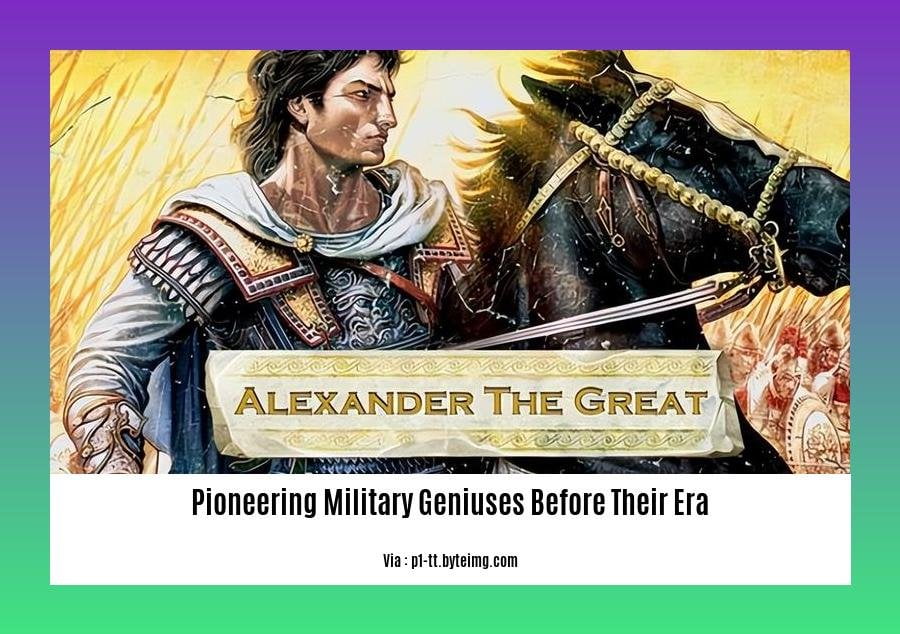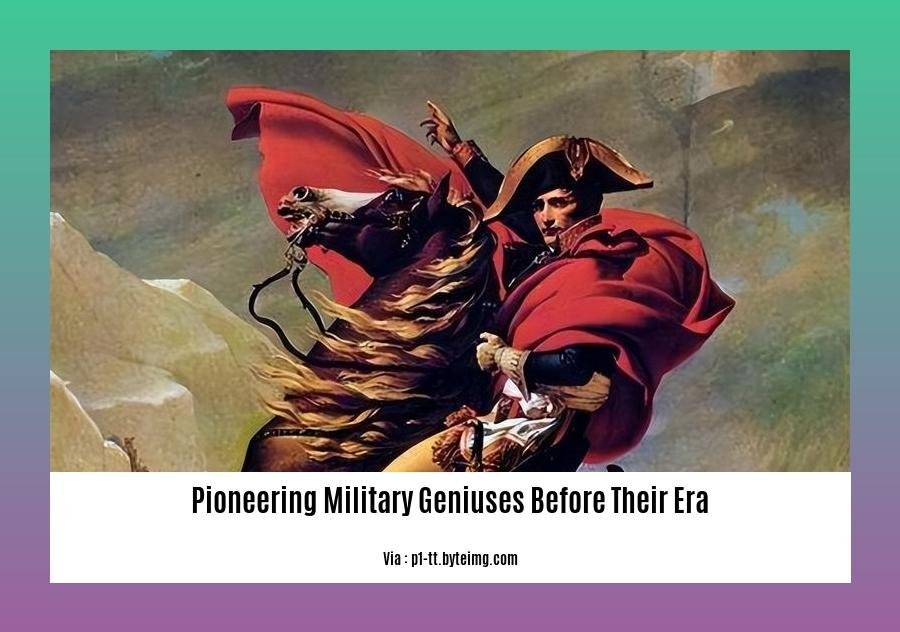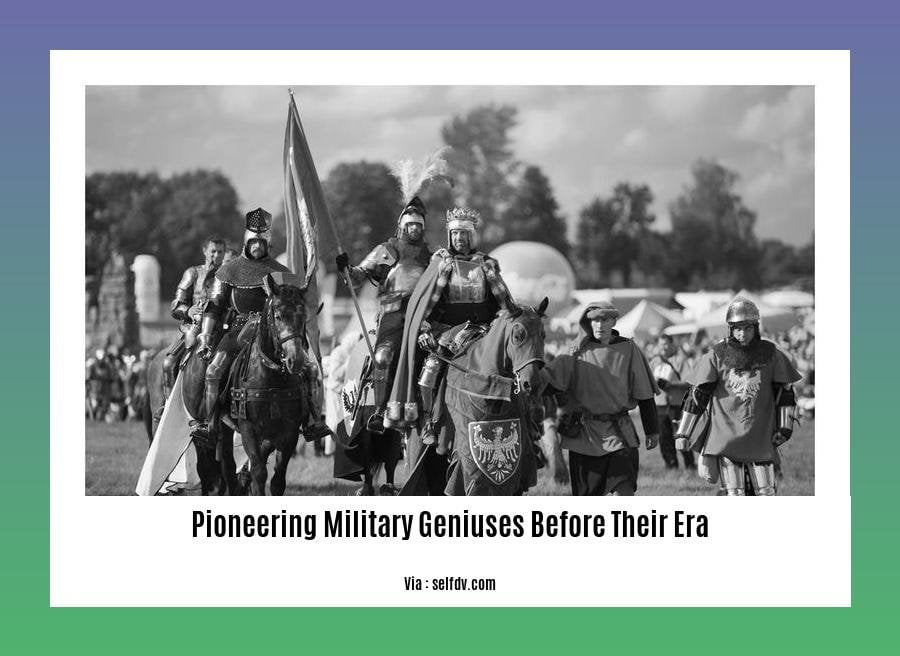Step into the annals of warfare and meet the extraordinary military visionaries who challenged norms and reshaped the art of war. In “Pioneering Military Geniuses Before Their Era,” we embark on a journey through time, unraveling the remarkable stories of individuals whose strategic brilliance blazed a trail for generations to come.
Key Takeaways:

- Military geniuses possess exceptional strategic and tactical abilities.
- They have the ability to lead armies and make rational decisions under pressure.
- Their brilliance and tactical knowledge enable them to overcome incredible odds.
- Attributes of military geniuses include intellectual prowess, physical stamina, emotional resilience, and psychological influence.
- Notable examples of military geniuses include Alexander the Great, Napoleon Bonaparte, and George Washington.
- Military genius is still relevant in modern warfare, where understanding of policy and technology is crucial.
Pioneering Military Geniuses Before Their Era
Throughout history, a select few military masterminds have emerged, defying the conventions of their time. These pioneering military geniuses before their era possessed an unparalleled understanding of warfare, revolutionizing strategies and tactics.
Traits of Military Genius
Military geniuses often exhibited a combination of extraordinary qualities, including:
- Intellectual Supremacy: Keen analytical skills, strategic foresight, and innovative thinking.
- Tactical Brilliance: Ability to outmaneuver opponents, anticipate their moves, and create unexpected formations.
- Emotional Resilience: Calmness under pressure, unwavering determination, and the ability to inspire troops.
- Technological Savvy: Understanding of emerging technologies and their potential for military advantage.
Examples of Trailblazing Geniuses
History abounds with examples of pioneering military geniuses before their era, who transformed the face of warfare:
- Sun Tzu (5th Century B.C.): Chinese military strategist and philosopher, author of “The Art of War,” a seminal work on deception and unconventional tactics.
- Hannibal Barca (3rd Century B.C.): Carthaginian general known for his daring tactics, including the legendary crossing of the Alps with elephants.
- Julius Caesar (1st Century B.C.): Roman military leader and statesman, renowned for his innovative use of siege warfare and his famous phrase, “I came, I saw, I conquered.”
- Napoleon Bonaparte (18th-19th Century): French military genius, known for his rapid maneuvers, artillery tactics, and his rise to power as Emperor of France.
- Erwin Rommel (20th Century): German general, nicknamed the “Desert Fox,” who employed unconventional tank tactics during World War II.
These pioneering military geniuses before their era not only shaped battles but also left an enduring legacy on military strategy and tactics, inspiring generations of commanders.
Looking through the annals of history, one can find innovative military commanders ahead of their time. These groundbreaking commanders who upended traditions were not afraid to challenge the status quo and revolutionize the way warfare was conducted. Such as visionary military leaders who revolutionized warfare.
Hannibal Barca: Crossing the Alps and Envelopment Tactics
Hannibal Barca: Crossing the Alps
Probably the most celebrated campaign in military history is Hannibal’s crossing of the Alps in 218 B.C., during the Second Punic War. Leading a Carthaginian army, Hannibal crossed the Alps and invaded Italy.
His army of 26,000 infantry, 6,000 cavalry, and 37 war elephants marched over 1,000 miles, crossing the Rhone, and traversing treacherous mountain passes in the Alps. They faced extreme weather conditions, and hostile local tribes along the way.
At the Battle of Cannae, Hannibal’s army annihilated a larger Roman army. Hannibal’s tactics, which relied on envelopment and the double envelopment, are still studied by military strategists today.
Envelopment Tactics
Envelopment: An envelopment is a military maneuver in which an attacking force attempts to surround an enemy force on one or both flanks, thereby cutting off its lines of retreat.
Double Envelopment: A double envelopment is a military maneuver in which an attacking force attempts to surround an enemy force on both flanks, thereby completely cutting off its lines of retreat.
Crossing the Alps
Hannibal’s crossing of the Alps was a daring and risky maneuver that caught the Romans by surprise. By crossing the Alps, he was able to avoid the heavily defended Roman roads and launch a surprise attack on Italy.
The crossing was extremely difficult, and Hannibal lost many men and animals along the way. He was also opposed by hostile local tribes, who harassed his army as it made its way through the mountains.
Key Takeaways:
- Hannibal Barca was one of the greatest military commanders in history.
- His crossing of the Alps was a daring and risky maneuver that caught the Romans by surprise.
- Hannibal’s tactics, which relied on envelopment and the double envelopment, are still studied by military strategists today.
Napoleon Bonaparte: Artillery and Combined Arms
Napoleon Bonaparte’s military legacy is undeniably impressive. His revolutionary approach to warfare, particularly in the areas of artillery and combined arms, reshaped military strategy and tactics for generations to come.
Napoleon recognized the immense power of artillery, transforming it from a secondary weapon to a crucial component of his military might. He revolutionized the Ordnance System, introducing advanced theories and improved technology that enhanced the range, accuracy, and firepower of his cannons.
Furthermore, Napoleon pioneered the concept of combined-arms units, seamlessly integrating cavalry, infantry, and artillery into cohesive fighting forces. This innovative approach allowed his armies to maneuver with unprecedented speed and flexibility, overwhelming opponents with a devastating combination of firepower and mobility.
Key Takeaways:
- Napoleon’s revolutionary use of artillery: Transformed it from a secondary weapon to a critical force multiplier.
- Combined-arms units: Integrated cavalry, infantry, and artillery for exceptional mobility and firepower.
- Tactical genius: Deployed innovative tactics that led to numerous battlefield victories.
- Emphasis on training and discipline: Rigorously trained his troops for efficient battlefield execution.
Citation:
- Napoleon Bonaparte: A military life
Erwin Rommel: Blitzkrieg and Desert Warfare
Erwin Rommel, known as the “Desert Fox”, was a German field marshal who left an indelible mark on military strategy, particularly in the realm of blitzkrieg and desert warfare during World War II.
Blitzkrieg: The Lightning War
Rommel’s blitzkrieg tactics, characterized by swift, concentrated attacks supported by armored and motorized units, proved devastating. By rapidly penetrating enemy lines and bypassing strongpoints, he exploited the element of surprise, disrupting communications and sowing chaos. Rommel’s masterful use of blitzkrieg in the invasion of France and Poland earned him both victory and admiration.
Desert Warfare: The Fox in North Africa
Rommel’s genius extended to desert warfare in North Africa. Faced with vast and unforgiving terrain, he adapted his tactics, emphasizing mobility, reconnaissance, and deception. Rommel’s ability to outmaneuver and defeat larger Allied forces in the North African campaign cemented his reputation as a brilliant military commander.
Key Takeaways:
- Rommel’s blitzkrieg tactics revolutionized warfare, emphasizing speed, surprise, and concentrated force.
- His expertise in desert warfare showcased his ability to adapt and excel in challenging environments.
- Rommel’s innovative strategies and tactical brilliance continue to be studied and emulated by military strategists.
Relevant URL Source:
Erwin Rommel – Biography, Facts & Death

FAQ
Q1: What key attributes distinguish military geniuses from their contemporaries?
Q2: How did Hannibal’s crossing of the Alps shape the course of military strategy?
Q3: What innovative tactics and principles did Napoleon Bonaparte introduce to warfare?
Q4: What characterized the military leadership of Erwin Rommel, particularly his “Desert Fox” persona?
Q5: How have the contributions of these pioneering military geniuses influenced modern military thought and practices?
- Georgia Platform: A Southern Strategy, 1850s - March 31, 2025
- How many weeks is 40 days: Quick Conversion Guide for Accurate Results - March 31, 2025
- How many feet is 300 meters? 984 Feet: Understand Length Conversions Easily - March 31, 2025
















